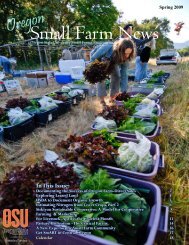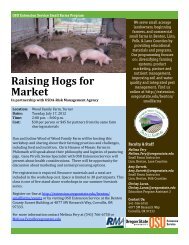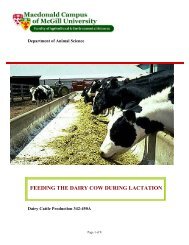Small Farm News - Oregon Small Farms - Oregon State University
Small Farm News - Oregon Small Farms - Oregon State University
Small Farm News - Oregon Small Farms - Oregon State University
You also want an ePaper? Increase the reach of your titles
YUMPU automatically turns print PDFs into web optimized ePapers that Google loves.
high gain in heat units by the soil. It absorbs little<br />
solar radiation but transmits up to 95% with relative<br />
transmission depending on the thickness and degree<br />
of opacity of the plastic. If you look closely, the<br />
underside of clear plastic mulch usually is covered<br />
with condensed water droplets. These droplets are<br />
transparent to incoming shortwave radiation but do<br />
not transmit outgoing longwave infrared radiation,<br />
therefore, tremendously increasing the heat gain in<br />
the soil. On clear sunny days, soil temperatures under<br />
clear plastic mulch are generally 6 to 14° F higher at a<br />
2-4-inch depth compared to those of bare soil. Weeds<br />
can be a big problem under clear mulch but in the<br />
fall, the physiology of most weed seeds prevents them<br />
from germinating and competing with crops. Also it is<br />
recommended to use transplants for fall crops thereby<br />
eliminating germination problems under plastic cover.<br />
Red Plastic Mulch<br />
Red plastic mulches have been used substantially in<br />
tomato production because some experiments have<br />
shown up to 12% increase in marketable fruit yield<br />
compared to other plastics. However, when environmental<br />
conditions<br />
for<br />
plant<br />
growth<br />
are ideal,<br />
the red<br />
plastic<br />
mulches’<br />
influence<br />
on yield<br />
is minimal.<br />
In<br />
terms<br />
of soil<br />
Red plastic mulch has been shown to improve up to 12% increase in<br />
marketable fruit yield of tomatoes compared to other plastics in years<br />
when environmental conditions are not normal.<br />
Photo provided by Sam Angima<br />
warming, they perform like black mulch but cost-wise<br />
are more expensive.<br />
Infrared-Transmitting Mulch<br />
These mulches are intermediate between black and<br />
clear plastic mulch in terms of increasing soil temperature.<br />
The color of these mulches can be blue-green<br />
or brown. The advantage with these plastic mulches is<br />
being able to warm soil temperatures without the weed<br />
problem of clear plastic mulches.<br />
White, White-On-Black, or Silver Reflecting Mulch<br />
These plastics are not recommended for fall crops<br />
because they can result in a slight decrease in soil<br />
temperatures. They usually reflect solar radiation back<br />
into the plant canopy and are usually used in summer<br />
when soil temperatures need to be cooler.<br />
BIODEGRADABLE MULCHES<br />
Despite the low<br />
cost of black<br />
plastic mulches,<br />
the overall cost<br />
of disposing used<br />
mulches is quite<br />
high. That is why<br />
there is a move to<br />
develop biodegradable<br />
plastic mulches.<br />
Biodegradable<br />
plastics are made<br />
Compostable plastic is stable until the end of the growing<br />
season but can be tilled in or composted<br />
Photo provided by Sam Angima<br />
with starches from plants such as corn, wheat, and<br />
potatoes. They are broken down by microbes. Field<br />
studies on tomato and pepper crops have shown that<br />
biodegradable plastic mulches perform just as well as<br />
polyethylene film, and they can simply be plowed into<br />
the ground after harvest. Another advance in this technology<br />
is the photodegradable plastic mulch that also<br />
comes in tinted brown, black and clear. It degrades<br />
with sunlight with time but the section in contact<br />
with the soil does not degrade and has to be removed<br />
later. Other mulch options (and some are still under<br />
development) include paper mulch, planters paper, and<br />
recycled Kraft paper.<br />
It is important to remember that growing crops in the<br />
fall under protection requires soil warmth as well as<br />
above ground warmth coupled with providing enough<br />
light for photosynthesis. Ultimately, the market price<br />
and prevailing markets of produce will determine the<br />
profitability of growing late fall crops. What is certain<br />
is that more and more people are demanding locally<br />
grown foods and those growers who innovate to<br />
capture this market will benefit from investing in late<br />
season crop production.<br />
[Content credit: ATTRA Season Extension Techniques for Market<br />
Gardeners, Center for Plasticulture at Penn <strong>State</strong> <strong>University</strong> and<br />
North Carolina A&T <strong>State</strong> <strong>University</strong> Black Plastic Mulch Program]<br />
<strong>Oregon</strong> <strong>Small</strong> <strong>Farm</strong> <strong>News</strong> Vol. IV No. 3 Page 18















